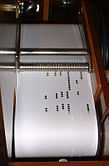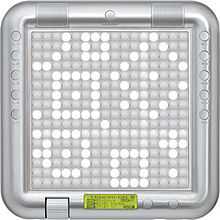Music sequencer
A music sequencer (or simply sequencer) is a device or application software that can record, edit, or play back music, by handling note and performance information in several forms, typically MIDI or CV/Gate, and possibly audio and automation data for DAWs and plug-ins.
Overview
Types of music sequencers
As mentioned above, music sequencers are often categorized by handling data types, as following:
- MIDI data on the MIDI sequencers (implemented as hardware or software)
- CV/Gate data on the analog sequencers, and possibly others (via CV/Gate interfaces).
- Automation data for DAWs and plug-ins.
- on the DAW with sequencing features, and software instrument/effect plug-ins on them.
- Audio data
- on the audio sequencers[note 1] including DAW, loop-based music software, etc.;
or, the phrase samplers including Groove machines, etc.
-
Also, music sequencer can be categorized by its construction and supporting modes.
- Realtime sequencer (realtime recording mode)

- Realtime sequencers record the musical notes in real-time as on audio recorders, and play back musical notes with designated tempo, quantizations, and pitch. For editing, usually "punch in/punch out" feature originated in the tape recording is provided, although it requires enough skills to obtain desired result. For detailed editing, possibly another visual editing modes under graphical user interface may be more suitable. Anyway, this mode provides usability similar to the audio recorder already familiarized by musicians, and it is widely supported on software sequencer, DAW, and built-in hardware sequencers.
- Analog sequencer
- Analog sequencers are typically implemented with analog electronics, and play the musical notes designated by a series of knobs or sliders corresponding to each musical note (step). It is designed for both composition and live performance; users can change the musical notes at any time without regarding recording mode. And also possibly, the time-interval between each musical note (length of each step) can be independently adjustable. Typically, analog sequencer is used to generate the repeated minimalistic phrases which is reminiscent of Tangerine Dream, Giorgio Moroder or trance music.
- Step sequencer (step recording mode)

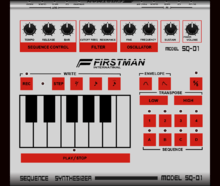
- On the step sequencers, musical notes are rounded into the steps of equal time-interval, and users can enter each musical note without exact timing; Instead, each timing and duration of step are designated in several ways:
- On the drum machines: select a trigger timing from a row of step-buttons.
- On the bass machines: select a step note (or rest) from a chromatic keypads, then select a step duration (or tie) from a group of length-buttons, sequentially.
- On the several home keyboards: in addition to the realtime sequencer, a pair of step trigger button is provided; using it, notes on the pre-recorded sequence can be triggered in arbitrary timings for the timing dedicated recordings or performances. (See #Step sequencers (supported on))
- In general, step mode, along with roughly quantized semi-realtime mode, is often supported on the analog drum machines, bass machines and several groove machines.
- Software sequencer
- Software sequencer is a class of application software providing a functionality of music sequencer, and often provided as one feature of the DAW or the integrated music authoring environments. The features provided as sequencers vary widely depending on the software; even an analog sequencer can be simulated. The user may control the software sequencer either by using the graphical user interfaces or a specialized input devices, such as a MIDI controller.
Modern sequencers



With the advent of the Musical Instrument Digital Interface (MIDI), and particularly the Atari ST home computer in the 1980s, programmers were able to write software that could record and play back the notes played by a musician. Unlike the early sequencers used to play mechanical sounding sequence with exactly equal length, the new ones recorded and played back expressive performances by real musicians. These were typically used to control external synthesizers, especially rackmounted sound modules, as it was no longer necessary for each synthesizer to have its own keyboard.
As the technology matured, sequencers gained more features, and integrated the ability to record multitrack audio. Sequencers mainly used for audio are often called digital audio workstations (or DAWs).
Many modern sequencers can also control virtual instruments implemented as software plug-ins, allowing musicians to replace separate synthesizers with software equivalents.
Today the term "sequencer" is often used to describe software. However, hardware sequencers still exist. Workstation keyboards have their own proprietary built-in MIDI sequencers. Drum machines and some older synthesizers have their own step sequencer built in. There are still also standalone hardware MIDI sequencers, although the market demand for those has diminished greatly due to the greater feature set of their software counterparts.
History
Early sequencers



controlled via wide punched paper roll
The early music sequencers had appeared in the form of various automatic musical instruments, including music boxes, mechanical organs, player pianos, Orchestrions, etc. For example, authoring process of piano roll fits the definition of "music sequencer": composers record their music composition on the piano rolls, then specialists edit the rolls as the preparation before mass duplication, and finally consumers play back the music on their player pianos.
The origin of automatic musical instruments seems considerably old. As early as the 9th century, Persian inventors Banū Mūsā brothers invented hydropowered organ using exchangeable cylinders with pins,[2] and also automatic flute player using steam power,[3][4] as described on their Book of Ingenious Devices. In the 14th century, rotating cylinder with pins were used to play carillon in Flanders, and at least in the 15th century, barrel organs were seen in the Netherlands.[5]
In the 19th century, as the results of Industrial Revolution, various automatic musical instruments were invented, for examples: music box, barrel organ and barrel piano using barrel / cylinder with pins or metal disc with punched holes; or mechanical organ, player piano and orchestrion using book music / music rolls (piano rolls) with punched holes, etc. These instruments were widely spread as the popular entertainment devices before the inventions of phonograph, radio, and sound film. Amongst of all, especially the punched tape media had been long lived until the mid-20th century: earliest programmable music synthesizers including RCA Mark II Sound Synthesizer in 1957, and Siemens Synthesizer in 1959, were also controlled via punch tapes similar to piano rolls.[6][7][8]
Another inventions were came from sound film technology. The drawn sound technique which appeared in the late 1920s, is notable as a precursor of today's intuitive graphical user interfaces. On this technique, notes and various sound parameters were controlled by hand-drawn waves on the films, resembling piano rolls or strip charts on the modern sequencers/DAWs. It was often utilized on early experiments of electronic music, including Variophone developed by Yevgeny Sholpo in 1930, and Oramics designed by Daphne Oram in 1957, etc.
Analog sequencers

_%40_Stearns_Collection_(Stearns_2035)%2C_University_of_Michigan.jpg)
During the 1940s–1960s, Raymond Scott, an American composer of electronic music, invented various kind of music sequencers for his electric compositions. The "Wall of Sound", once covered on the wall of his studio in New York during the 1940s–1950s, was an electro-mechanical sequencer to produce rhythmic patterns, consisting of stepping relays (used on dial pulse telephone exchange), solenoids, control switches, and tone circuits with 16 individual oscillators.[10] Later, Robert Moog explained it "the whole room would go 'clack - clack - clack', and the sounds would come out all over the place".[11] The Circle Machine, developed in 1959, had dimmer bulbs arranged in a ring, and a rotating arm with photocell scanning over the ring, to generate arbitrary waveform. Also, the rotating speed of arm was controlled via brightness of lights, and as the results, arbitrary rhythms were generated.[12] And relatively well known Clavivox, developed since 1952, was a kind of keyboard synthesizer with sequencer. On its prototype, a theremin manufactured by young Robert Moog was utilized to enable portamento over 3-octave range, and on later version, it was replaced by a pair of photographic film and photocell for controlling the pitch by voltage.[11]
In 1965 Ralph Lundsten had a polyphonic synthesizer with sequencer called Andromatic. built for him by Erkki Kurenniemi.[13]
Step sequencers
_disc_sequencer.jpg)

The step sequencers played rigid patterns of notes using a grid of (usually) 16 buttons, or steps, each step being 1/16 of a measure. These patterns of notes were then chained together to form longer compositions. Sequencers of this kind are still in use, mostly built into drum machines and grooveboxes. They are monophonic by nature, although some are multi-timbral, meaning that they can control several different sounds but only play one note on each of those sounds.
Computer music
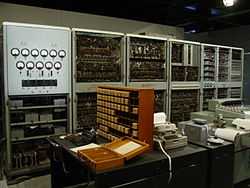
On the other hand, software sequencers were continuously utilized since the 1950s in the context of computer music, including computer-played music (software sequencer), computer-composed music (music synthesis), and computer sound generation (sound synthesis). In June 1951, the first computer music Colonel Bogey was played on CSIRAC, Australia's first digital computer.[17][18] In 1956, Lejaren Hiller at the University of Illinois at Urbana-Champaign wrote one of the earliest programs for computer music composition on ILLIAC, and collaborated on the first piece, Illiac Suite for String Quartet, with Leonard Issaction.[19] In 1957 Max Mathews at Bell Labs wrote MUSIC, the first widely used program for sound generation, and a 17 second composition was performed by the IBM 704 computer. Subsequently, computer music was mainly researched on the expensive mainframe computers in computer centers, until the 1970s when minicomputers and then microcomputers became available in this field.
Digital sequencers

%2C_Synthesizer_Festa_2012_in_Shinjuku.jpg)
In 1971, Electronic Music Studios (EMS) released one of the first digital sequencer products as a module of Synthi 100, and its derivation, Synthi Sequencer series.[20][21] After then, Oberheim released DS-2 Digital Sequencer in 1974,[22] and Sequential Circuits released Model 800 in 1977 [23]
Also in 1977, Roland Corporation released their first microcomputer-based digital sequencer, MC-8 Microcomposer, also called computer music composer by Roland.[24] It equipped keypad to enter note in numeric code, 16KB RAM for maximum 5200 notes (large enough at that time), and polyphony function which allocates multiple pitch CV into single Gate.[25] The earliest known user was Yellow Magic Orchestra in 1978.
Software sequencers
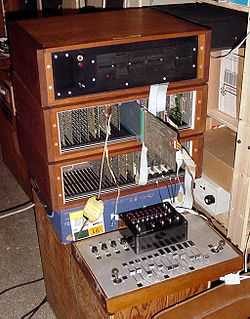

In 1975, New England Digital (NED) released ABLE computer (microcomputer)[26] as a dedicated data processing unit for Dartmouth Digital Synthesizer (1973), and based on it, later Synclavier series were developed. The Synclavier I, released in September 1977,[27] was one of the earliest digital music workstation product with multitrack sequencer. Synclavier series evolved throughout the late-1970s to the mid-1980s, and they also established integration of digital-audio and music-sequencer, on their Direct-to-Disk option in 1984, and later Tapeless Studio system.

In 1980, renewed Fairlight CMI Series II with its sequencer, "Page R", combined step sequencing with sample playback. In 1987, this led to the development of similar software sequencers of this kind, called Trackers, which became popular in the 1980s and 1990s as simple sequencers for creating computer game music, and are yet popular in the demoscene and chiptunes.
Visual timeline of rhythm sequencers
_Consert_Orchestrion_(style_6%2C_no198%2C_1895).jpg) Mechanical (pre 20c) |
Rhythmicon (1930) |
.jpg) Drum machine |
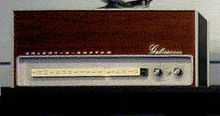 Transistorized drum machine (mid-1960s) |
 Step drum machine (1972–) |
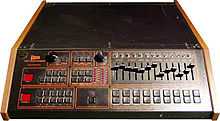 Digital drum machine (1980–) |
 “Page R” on Fairlight (c.1980) |
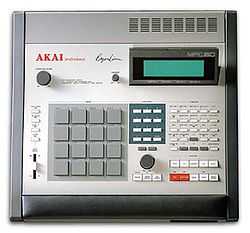 Groove machine (mid-1980s–) |
Tracker (1987–) |
 Beat slicer (1990s–) |
Spectrogram editing (1994) |
 Loop sequencer (1998–) |
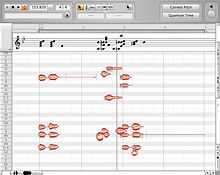 Note manipulation on audio tracks (2009–) |
Hardware sequencers
Many synthesizers, and by definition all music workstations, groove machines and drum machines, contain their own sequencers.
Followings are specifically designed to function primarily as the music sequencers:
Rotating object with pins or holes
- Barrel or cylinder with pins (since 9th or 14th century) utilized on barrel organs, carillons, music boxes
- Metal disc with punched holes (late 1800s) — utilized on several music boxes such as Polyphon, Regina, Symphonion, Ariston, Graphonola (early version), etc.
Punched paper
- Book music (since 1890) utilized on several mechanical organs
- Music roll utilized on player pianos (using piano rolls), Orchestrions, several mechanical organs, etc.
- Punch tape system for earliest studio synthesizers
- RCA Mark II Sound Synthesizer (1957) by Herbert Belar and Harry Olson at RCA
- Room-filling device built in 1957 for half a million dollars. Included a 4-polyphony synth with 12 oscillators, a sequencer fed with wide paper tape, and output were recorded on a shellac record lathe.
- Siemens Synthesizer (1959) at Siemens-Studio für elektronische Musik[7][8]
- RCA Mark II Sound Synthesizer (1957) by Herbert Belar and Harry Olson at RCA
Sound-on-film
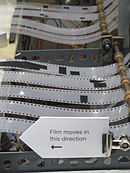
- Variophone (1930) by Evgeny Sholpo — on earliest version, hand drawn waves on film or disc were used to synthesize sound, and later versions were promised to experiment on musical intonations and temporal characteristics of live music performance, however not finished. Variophone is often referred as a forerunner of drawn sound system including ANS synthesizer and Oramics.
- Composer-Tron (1953) by Osmond Kendal — rhythmical sequences were controlled via marking cue on film, while timbre of note or envelope-shape of sound were defined via hand drawn shapes on a surface of CRT input device, drawn with a grease pencil.[28]
- ANS synthesizer (1938-1958) by Evgeny Murzin — An earliest realtime additive synthesizer using 720 microtonal sine waves (1/6 semitones × 10 octaves) generated by five glas discs. Composers could control time evolution of amplitudes of each microtones via scratches on glass plate user interface covered with black mastic.
- Oramics (1957) by Daphne Oram — hand drawn contours on a set of ten sprocketed synchronized strips of 35 film were used to control various parameters of monophonic sound generator (frequency, timbre, amplitude and duration).[29] Polyphonic sounds were obtained using multitrack recording technique.
Electro-mechanical sequencers
_front_view.jpg)
- Wall of Sound (mid-1940s–1950s) by Raymond Scott — early electro-mechanical sequencer developed by Raymond Scott to produce rhythmic patterns, consistent with stepping relays, solenoids, and tone generators.[10]
- Circle Machine (1959) by Raymond Scott — electro-optical rotary sequencer developed by Raymond Scott to generate arbitrary waveforms, consistent with dimmer bulbs arranged in a ring, and a rotating arm with photocell scanning over the ring.[12]
- Wurlitzer Sideman (1959) — first commercial drum machine; rhythm patterns were electro-mechanically generated by rotating disk switches, and drum sounds were electronically generated by vacuum-tube circuits.[30]
Analog sequencers
- Analog sequencers with CV/Gate interface
- See also: § Analog-style MIDI step sequencers

- Buchla 100's sequencer modules (1964/1966–) — One of the earliest analog sequencer on the modular synthesizer era since 1960. Later, Robert Moog admired Buchla's unique works including it.[9]
- Moog 960 Sequential Controller[31] / 961 Interface[32] / 962 Sequential Switch[33] (c.1968)[34]
- modules for the Moog modular synthesizer system, a popular analog sequencer following earliest Buchla sequencer.
|
Analog-style step sequencers
- Analog-style MIDI step sequencers
- Since the analog synthesizer revivals in the 1990s, newly designed MIDI sequencers with a series of knobs or slider similar to analog sequencer have been appeared. These often equip CV/Gate and DIN sync interface along with MIDI, and even the patch memory for multiple sequence patterns and possibly song sequence. These analog-digital hybrid machines are often called "Analog-style MIDI step sequencer" or "MIDI analog sequencer", etc.

- Doepfer MAQ 16/3 — MIDI analog sequencer, designed in cooperation with Kraftwerk
- Doepfer Regelwerk — MIDI analog sequencer with MIDI controller
- Frostwave Fat Controller
- Infection Music Phaedra
- Infection Music Zeit
- Latronic Notron
- Manikin Schrittmacher
- Quasimidi Polymorph (1999) — Four-part multitimbral tabletop synthesizer, with an analog-like step sequencer.
- Roland EF-303 – Multiple effects unit with 16-step modulation, also usable as the analog-style MIDI step sequencer.[37]
- Sequentix P3
- Analog-style MIDI pattern sequencers
- Several machines also provide the song mode to play the sequence of memoried patterns in specified order, as on drum machine.
- Doepfer Schaltwerk —MIDI pattern sequencer
Step sequencers (supported on)
- Typical step sequencers are integrated on drum machines, bass machines, groove machines, music production machines, and these software versions. Often, these also support the semi-realtime recording mode, too.
- MFB Step 64 — Standalone step sequencer dedicated for drum patterns (16steps/4tracks or 64steps/1tracks, 118program×4banks, 16song sequences, each with up to 128 sequences)[38]
- Embedded self-contained step sequencers
- Several tiny keyboards provide a step sequencer combined with an independent timing mode for recording and performance:
- Casio VL-Tone VL-1 (1979), Casiotone MT-70 (c.1984), Sampletone SK-1 (1986), etc — Timings of musical notes stored on the step sequencer, can be designated by the two trigger buttons labeled "One Key Play", around the right hand position.
- Embedded CV/Gate step sequencers
- Several machines have white & black chromatic keypads, to enter the musical phrases.
- Multivox / Firstman SQ-01 (1980) — a forerunner of TB-303
- Roland TB-303 (1981)
- Roland SH-101 (1982) — monophonic keytar synthesizer with sequencer
- Roland MC-202 (1983) — monophonic tabletop synthesizer with sequencer, similar to MC-101
- Embedded MIDI step sequencers
- Groovebox-type machines with white & black chromatic keypads, often support step recording mode along with realtime recording mode:
|
- Other groovebox-type machines (including several music production machines) also often support step recording mode, of course:
|
|
- Button-grid-style step sequencers
- Recently emerging button-grid-style interfaces/instruments are naturally support step sequence. On these machines, one axis on grid means musical scale, and another axis means timing of notes.
- In addition, newly designed hardware MIDI sequencers equipping a series of knobs/sliders similar to analog sequencers, are appeared. For details, see #Analog-style MIDI step sequencers.
Digital sequencers
|
|
- Proprietary digital interfaces (pre MIDI era)
- NED Synclavier series — CV/Gate interface and MIDI retrofit kit were available on Synclavier II. Also MIDI became standard feature on Synclavier PSMT.[40][41]
- Fairlight CMI series — CV/Gate interface was optionally available on Series II, and MIDI was supported on Series IIx and later models.
- Oberheim DSX (Oberheim Parallel Bus)
- PPG Wave family (PPG Bus)
- Rhodes Chroma (Chroma Computer Interface)[42]
- Roland JSQ-60 (Roland Digital Control Bus (DCB))
- Sequential Circuits PolySequencer 1005 (SCI Serial Bus)
- Yamaha CS70M (Key Code Interface)[43]
MIDI sequencers
- Standalone MIDI sequencers
|
- MIDI phrase sequencers
- Zyklus MPS
- MIDI sequencers with embedded sound module
- Yamaha TQ5 — desktop version of EOS YS200 FM workstation
- Yamaha QY300 — with embedded sound module
- Yamaha QY700 — with embedded sound module
- Palmtop MIDI sequencers

-
- Korg SQ-8 — palmtop sequencer
- Philips Micro Composer PMC100
- Roland PMA-5 — palmtop sequencer with touch screen
- Yamaha Walkstation series: MU5/MU10/MU15/QY8/QY10/QY20/QY22/QY70/QY100 — palmtop sequencer with embedded sound module.
- Accompaniment machines
-
.jpg)
.jpg)
- Boss DR-5 Dr.Rhythm Section
- Yamaha QR10 Musical Accompaniment Player
- etc.
Open-source hardware
- MIDIbox Sequencer modules — Analog-style MIDI step sequencer/MIDI effect processor modules of MIDIbox project
Software sequencers and DAWs with sequencing features
Free/Open Source
- Scorewriters
- MuseScore — Linux, Windows, Mac OS X
- DAW with MIDI sequencers
- Ardour — Linux, Mac OS X, FreeBSD
- LMMS — Linux, Windows
- MusE — Linux
- Qtractor — Linux
- Rosegarden — Linux
- Drum machines
- Hydrogen — Linux, Mac OS X
Commercial
- MIDI sequencers
- B-Step Sequencer from Monoplugs
- Master Tracks Pro from Passport Music Software
- Loop-oriented DAWs with MIDI sequencers
- ACID Pro and Cinescore from Sony Creative Software
- Live from Ableton
- GarageBand from Apple
- REAPER from Cockos
- Tracktion from Mackie
- Tracker-oriented DAWs with MIDI sequencers
- DAWs with MIDI sequencers
- Ableton Live from Ableton
- Cubase and Nuendo from Steinberg
- Digital Performer from MOTU
- FL Studio from Image Line Software
- Logic Pro and Logic Express from Apple
- Mixcraft from Acoustica
- Orion Platinum from Synapse Audio
- Pro Tools from Avid
- Samplitude, Sequoia, Music Maker and Music Studio from Magix
- Sonar and Home Studio from Cakewalk
- Studio One from PreSonus
- Podium from Zynewave (gratis)
- Z-Maestro from Z-Systems
- Integrated software studio environments
- Reason and Record from Propellerhead
- Storm from Arturia
See also
- Groovebox
- Music workstation
- Tracker (music software)
- Combination action (for organs)
Notes
- ↑ The term "audio sequencer" seems to be relatively new expression and seems to be not clearly defined, yet. For example, "DAW integrated with MIDI sequencer" is often referred as "Audio and MIDI sequencer". However, in this usage, the term "audio sequencer" is just a synonym for the "DAW", and beyond the scope of this article. In that case, please check Digital audio workstation.
References
- ↑ "Cubase 6 screenshot licensed under CC-BY-SA-3.0". Steinberg Media Technologies GmbH.
- ↑ Fowler, Charles B. (October 1967). "The Museum of Music: A History of Mechanical Instruments". Music Educators Journal (Music Educators Journal) 54 (2): 45–49. doi:10.2307/3391092. JSTOR 3391092.
- ↑ Koetsier, Teun (2001). "On the prehistory of programmable machines: musical automata, looms, calculators". Mechanism and Machine Theory (Elsevier) 36 (5): 589–603. doi:10.1016/S0094-114X(01)00005-2.
- ↑ Banu Musa (authors) (1979). Donald Routledge Hill (translator), ed. The book of ingenious devices (Kitāb al-ḥiyal). Springer. pp. 76–7. ISBN 9027708339.
- ↑
 Chisholm, Hugh, ed. (1911). "Barrel-organ". Encyclopædia Britannica (11th ed.). Cambridge University Press.
Chisholm, Hugh, ed. (1911). "Barrel-organ". Encyclopædia Britannica (11th ed.). Cambridge University Press. - ↑ "The RCA Synthesiser". 120 Years of Electronic Music (120years.net). — (PDF version is available)
- ↑ 7.0 7.1 "Das Siemens-Studio für elektronische Musik von Alexander Schaaf und Helmut Klein" (in German). Deutsches Museum.
- ↑ 8.0 8.1 Holmes, Thom (2012). "Early Synthesizers and Experimenters". Electronic and Experimental Music: Technology, Music, and Cluture (4th ed.). Routledge. pp. 190–192. ISBN 978-1-136-46895-7. (See also excerpt of pp. 157–160 from Holmes 2008)
- ↑ 9.0 9.1 Holmes, Thom (2008). Electronic and experimental music: technology, music, and culture (3rd ed.). Taylor & Francis. p. 222. ISBN 978-0-415-95781-6.
Moog admired Buchla's work, recently stating that Buchla designed a system not only for "making new sounds but [for] making textures out of these sounds by specifying when these sounds could change and how regular those change would be."
- ↑ 10.0 10.1 "Wall of Sound (sequencer)". RaymondScott.com.
- ↑ 11.0 11.1 Robert Moog. "Memories of Raymond Scott". RaymondScott.com.
- ↑ 12.0 12.1 "Circle Machine". RaymondScott.com. — includes 2 sound files: Raymond Scott's demonstration, and commercial soundtrack for new batteries of Ford Motors.
- ↑ Jörgen Städje (2012-10-06). "Andromatic, den automatiska andromedaren". International Data Group (IDG).
- ↑ "EKO Computerhythm (1972)". Jarrography - The ultimate Jean Michel Jarre discography.
- ↑ "EKO Computerhythm". SynthMaster.de.
- ↑ "Multivox International". SYNRISE (in German). Archived from the original on 2003-04-20.
- ↑ "CSIRAC: Australia's first computer". Australia: Commonwealth Scientific and Industrial Research Organisation (CSIRO). Retrieved 2007-12-21.
- ↑ Fildes, Jonathan (2008-06-17). "'Oldest' computer music unveiled". BBC News Online. Retrieved 2008-06-18. — another oldest known recording of computer realized music played by the Ferranti Mark 1, captured by BBC in Autumn, 1951; the songs Baa Baa Black Sheep and In the Mood.
- ↑ Hiller, Lejaren (Winter 1981). "Composing with Computer: A Progress Report". Computer Music Journal 5 (4).
also available in Curtis Roads (ed.). The Music Machine: Selected Readings from Computer Music Journal. MIT Press (1989/1992). pp. 75. ISBN 978-0-262-68078-3. - ↑ Hinton, Graham (2001). "Synthi 100 (1971, formerly Digitana, aka the Delaware)". Electronic Music Studios (Cornwall).
- ↑ Hinton, Graham (2001). "Synthi Sequencer 256 (1971, formerly Synthi Moog Sequencer)". Electronic Music Studios (Cornwall).
- ↑ J.Michmerhuizen (Boston School of Electronic Music); Thomas E. Oberheim (Oberheim Electronics) (June 1974). DS-2 Digital Sequencer Instruction and Service Manual (PDF).
- ↑ "Model 800 Sequencer". SynthMuseum.com.
- ↑ Russ, Martin (2008). Sound Synthesis and Sampling. Focal Press. p. 346. ISBN 0240521056. Retrieved 21 June 2011.
- ↑ Gordon Reid. "The History Of Roland Part 1: 1930-1978". Sound On Sound (Nov 2004). Retrieved 2011-06-19.
- ↑ "Synclavier Early History". Synclavier European Services.
- ↑ Joel Chadabe (May 1, 2001). "The Electronic Century Part IV: The Seeds of the Future". Electronic Musician.
In September 1977, I bought the first Synclavier, although mine came without the special keyboard and control panel ... (see Fig. 1 on the page).
- ↑ "The Composer-Tron (1953)". 120 Years of Electronic Music (120years.net).
- ↑ "Daphne Oram and 'Oramics' (1959)". 120 Years of Electronic Music (120years.net).
- ↑ US patent 3,207,835, Howard E. Holman and Joseph H. Hearne (Wurlitzer Company), "Rhythm Device", issued 1965-09-21
- ↑ "Moog 960 Sequential Controller". MoogArchives.com. — 3×8-step sequencer module
- ↑ "Moog 961 Interface". MoogArchives.com. — interface module to convert several signal types including audio input, V-trigger (CV), and S-trigger (short-to-ground trigger for Envelope Controller)
- ↑ "Moog 962 Sequential Switch". MoogArchives.com. — switching module for 960 to convert 3x8-step sequence into 1x24-step sequence, etc.
- ↑ "Synthesizer 2C with optional 960 and 961 - 1968 Modular System "Synthesizer 2"". MoogArchives.com. — On the MoogArchives.com, the photograph with caption "Synthesizer 2C with optional 960 and 961" on this page seems to be the earliest record of Moog's sequencer module.
- ↑ MFB-URZWERG, MFB Musik Elektronik
- ↑ MFB-URZWERG Pro, MFB Musik Elektronik
- ↑ Roland EF-303 Groove Effects - Owner's manual (PDF), Roland Corporation, pp. 48, 53, 54
- ↑ Sequencer MFB-STEP64, MFB Musik Elektronik
- ↑ "SM0600 Project - A Digital Sequencer - Rebuilding the Roland CSQ-700". Emulator Archive.
- ↑ Brandon Amison (17 Jul 1999). "Yaking Cat Music Studios QAQA answers - Subject:0033 Re:Clothing ETC.". Yaking Cat Music Studios (Synclavier Assistance).
- ↑ Furia, Steve De; Joe Scacciaferro (1986). The MIDI implementation book. Third Earth Pub. p. 25. ISBN 978-0-88188-558-3. — MIDI Implementation Chart of Synclavier MIDI Option v0.9 in 1985.
- ↑ Williams, Tonny (January 24, 1984), Rhodes Keyboards Instruments Chroma Computer Interface Model 1611 Rev 5 – Sequencer Manual (PDF), CBS Inc.
- ↑ "External Key Code Interface Circuit", Yamaha CS70M Servicing Manual (PDF), Yamaha Corporation, October 1981, p. 24
- ↑ "AM MSQ700 Nexus - MIDI Sequencer". Emulator Archive.
- Models
External links
| Look up sequencer in Wiktionary, the free dictionary. |
| Wikimedia Commons has media related to Music sequencers. |
- "History of electronic musical instruments and sequencers". 120 Years of Electronic Music (120years.net).
- "Early sequencer controllers". Vintage Synth Explorer.
- Richmond, Leigh (11 November 1974). "Computer hums its own music". Evening Times (Melbourne, FL). p. A1. (1974 newspaper article about digital sequencer)
- Raphael Arar; Ajay Kapur. "A History of Sequencers: Interfaces for Organizing Pattern-Based Music" (PDF). SMC 2013, Stockholm, Sweden. (A paper published after this Wikipedia article; Note: Ace Tone FR-1 Rhythm Ace mentioned on it is not a music sequencer nor first product of drum machine category)
| ||||||||||||||||||||||||||||||||||||||





